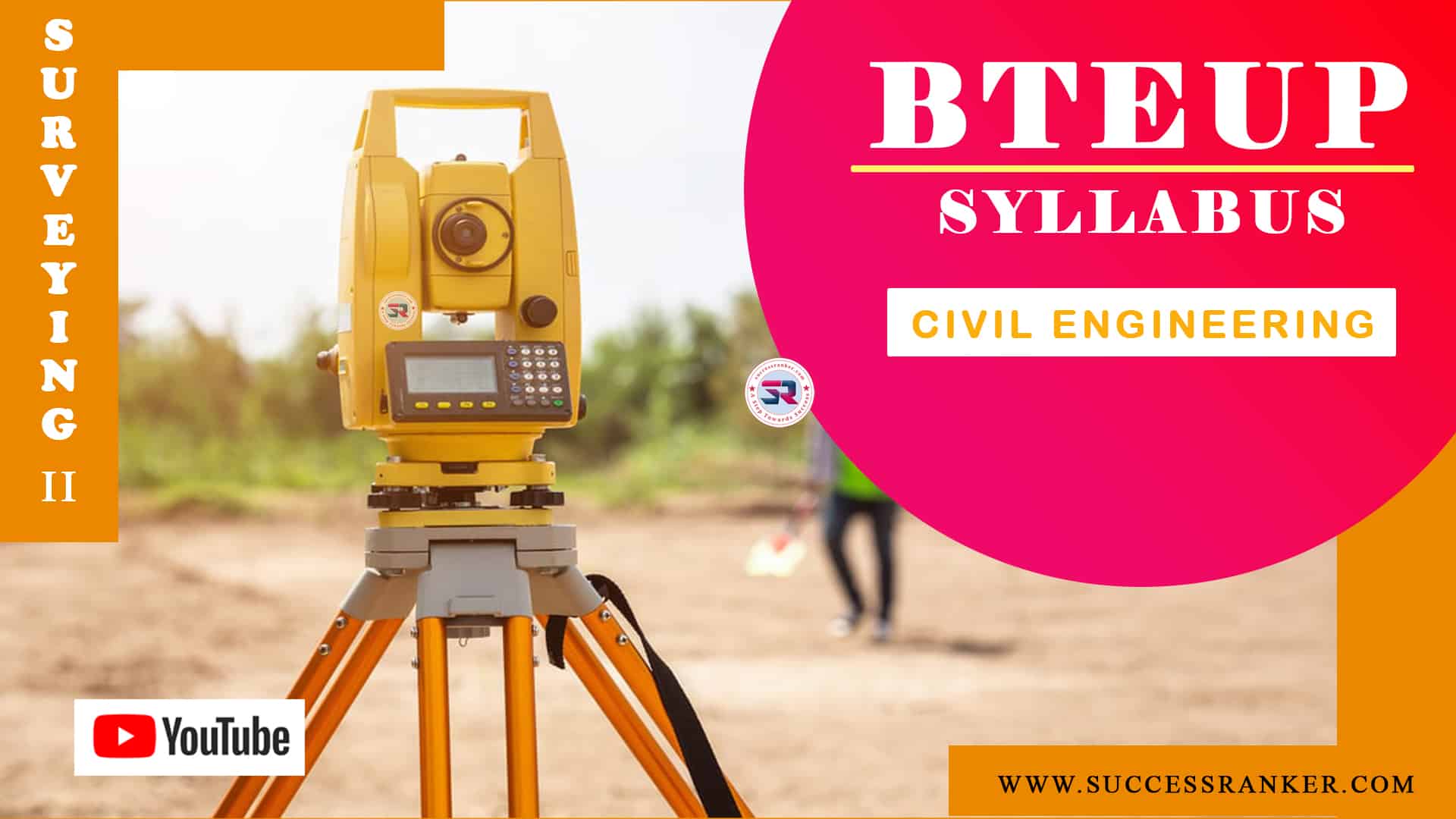BTEUP Fifth Semester Surveying Syllabus 2023
The students pursuing their diploma courses in the Board of Technical Education Uttar Pradesh can download Syllabus and the Previous Year’s Question Paper. If you are looking for the BTE Old Question Paper, and syllabus in Hindi, then this is the right place to download all the semester exam question papers as well as the syllabus. BTEUP Fifth Semester Surveying Syllabus is given below.
BTEUP Fifth Semester Surveying II Syllabus In Hindi
सर्वेक्षण वह विज्ञान हैं जिससे पृथ्वी की सतह पर स्थित बिंदुओं का समुचित माप लेकर, किसी पैमाने पर आलेखन (plotting) करके, उनकी सापेक्ष क्षैतिज और ऊर्ध्वाधर दूरियों का कागज या, दूसरे माध्यम पर सही-सही ज्ञान कराया जा सके। इस प्रकार का अंकित माध्यम ‘लेखाचित्र’ या मानचित्र कहलाता है।
The students looking for the BTEUP Civil Engineering Surveying II syllabus can download from the following links. Here we succcessranker provides syllabus in hindi language as well as enligh language. The syllabus will help the studnets to set up an idea to know the chapters and their content.
Chapter 1 समोच्च रेखण (Contouring)
1. प्रस्तावना (Introduction)
1.2 परिकल्पना (Concept)
1.3 परिभाषा (Definition)
1.4 समोच्च रेखण (Contouring)
1.5. समोच्च रेखण के उद्देश्य (Purpose of Contouring)
1.6 Contour Interval and Horizontal equivalent
1.7 क्षैतिज समतुल्य अन्तर (Horizontal Equivalent)
1.8 समोच्च रेखान्तर को प्रभावित करने वाले कारक (Factors Affecting the Contour Interval) 1.9 विभिन्न प्रकार के नक्शों के लिये रेखान्तर (Contour interval for Different maps)
1.10 समोच्च रेखाओं के लक्षण अर्थात् विशेषतायें (Characteristics of Contour Lines)
1.11 समोच्च रेखीय मानचित्रों का प्रयोग (Use of Contour Map)
1.12 समोच्च रेखा के प्रकार (Types of Contours)
1.13 समोच्च रेखण विधियाँ (Methods of Contouring)
1.14 समोच्च रेखण विधियों में अन्तर (Comparison between Direct and Indirect Methods)
1.15 समोच्च रेखाओं का अन्तर्वेशन (Interpolation of Contours)
1.16 नक्शे पर समोच्च रेखायें खींचना (To draw Contour Lines)
प्रश्नावली (Exercise)
Chapter 2 थियोडोलाइट सर्वेक्षण (Theodolite Survey)
2.1 परिचय (Introduction)
2.2 थियोडोलाइट का प्रयोग (Uses of a Theodolite)
2.3 Types of Theodolites (Main divisions of Theodolite)
2.4 Theodolite may also be Classified as
2.5 थियोडोलाइट का वर्गीकरण (Classification of Theodolite)
2.6 संक्रामी थियोडोलाइट के मुख्य भाग (Essential Parts of a Transit Theodolite)
2.7 तकनीकी शब्दावली (Some Technical Terms or Terminology)
2.8 Fundamental Axes of a Theodolite and Their Relation
2.9 थियोडोलाइट का पाठ्यांक पढ़ना (Reading a Theodolite)
2.10 थियोडोलाइट के समायोजन (Adjustment of a Theodolite)
2.11] क्षैतिज कोण मापना (To Measure the Horizontal Angle)
2.12 नहर या नदी की चौड़ाई मापना (To Measure Width of Canal or River)
2.13 नदी के पार दो बिन्दुओं के बीच क्षैतिज दूरी ज्ञात करना (To Measure the Horizontal Distance between two Inaccessible Points)
OR दो आगम्य बिन्दुओं के बीच क्षैतिज दूरी ज्ञात करना
(To Measure the Horizontal Distance between two Points across an Obstacle as Shown in fig)
2.14 उर्ध्वाधर कोण मापना (Measurement of Vertical Angle)
2.15 विशेष कोण मापना (To Measure Deflection Angle)
2.16 किसी रेखा का चुम्बकीय दिकमान मापना (To Measure Magnetic Bearing of Line)
2.17 रेखाओं के मध्य सीधा कोण मापन (To Measure Direct Angle of Traversing Line)
2.18 सर्वेक्षण रेखाओं का विस्तार करना (Prolonging a Line Forward or Backward) (Extending a Line)
2.19 दिये गये दो बिन्दुओं के बीच सीध बांधना अर्थात् दो बिन्दुओं के बीच सीप बाँधने के लिये मध्यवर्ती बिन्दु स्थापित करना (Ranging a Line between two Given Points or to Run a Straight Line between Two Points)
2.20 दो सीधी रेखाओं के काट बिन्दु को स्थापित करना (To Locate the Point of Intersection of two Straight Lines)
2.21 To Find out the Height of an Object
2.22 भूवक्रता तथा अपवर्तन का प्रभाव (Effect of Earth Curvature and Refraction)
2.23 थियोडोलाइट द्वारा तलेक्षण कार्य (Levelling with Theodolite)
2.24 थियोडोलाइट के स्थायी समंजन (Permanent Adjustment of Theodolite)
2.25 Errors in Theodolite
2.26 थियोडोलाइट माला देखण (Theodolite Traversing)
2.27 Types of Traverses
2.28 Following are the Two Stages of Work in Traversing
2.29 Theodolite Traversing
2.30 Methods of Theodolite Traversing
2.31 Traversing by the Method of Included Angles 232 Check-in a Closed Traverse or Characteristics of a Closed Traverse
2.33 Traversing by Deflection Angle
2.34 माला रेखा का आलेखन (Plotting of Traverse)
2.35 समापन त्रुटि (Closing Error or Error of Closure)
2.36 माता रेखा संगणनायें (Traverse Computation)
2.37 Independent Co-ordinates.
2.38 Consecutive Co-ordinates or Dependent Co-ordinates
2.39 Table for Consecutive Co-ordinates
2.40 Solved Examples
2.41 Problems on Latitude and Departure with Incomplete Data
2.42 बंद माला रेखा के क्षेत्रफल की गणना (Calculation of Transverse Area)
2.43 बंद माला रेखा के क्षेत्रफल की गणना
2.44 क्षेत्रफल की संगणना, अक्षांश व भुजांक द्वारा
प्रश्नावली (Exercises)
BTEUP Fifth Semester Surveying Syllabus in Hindi & English
Chapter 3 टैकियोमीटरिक सर्वेक्षण
(Tacheometric Survey)
3.1 टेकियोमीटरी सर्वेक्षण (Tacheometric Surveying)
3.2 टेकियोमीटरी सर्वेक्षण में प्रयोग होने वाले उपकरण (Instruments used in Tacheometric Survey)
3.3 टेकियोमीटर में वांछित अभिलक्षण (Characteristics of a Tacheometer)
3.4 स्टेडिया विधि का सिद्धान्त (Principle of Stadia System)
3.5 प्रयोगशाला विधि (Laboratory Measurement)
3.6 टेकियोमीटरी माप की विविध प्रणालियाँ (Different Systems of Tacheometric Measurements)
3.7 स्थिर तार विधि या स्टेडिया विधि (Fixed Hair Method or Stadia Method)
3.8 गतिशील तार विधि (The Movable Hair Method)
3.9 गज को ऊर्ध्वाधर पकड़ना (When line of the sight is Horizontal and Staff is Worked out Problem on Fixed Hair Method Held Vertical)
प्रश्नावली (Exercises)
Chapter 4 वक्र (Curves)
4.1 परिचय (Introduction)
4.2 मुख्य वर्गीकरण (Main Divisions of Curve)
4.3 आकार के आधार पर वक्रों का वर्गीकरण (Classification of Curves according to Shape)
4.4 वक्र का पद नाम (Designation of Curve)
4.5 वक्रता अंश या वक्रता की डिग्री (Degree of Curvature)
4.6 वक्रता त्रिज्या (R) तथा वक्रता अंश (Degree) में सम्बन्ध (Relation between Radius (R) and Degree of Curvature)
4.7 सरल वक्र • परिभाषायें एवं शब्दावली तथा संकेत –
(Simple Circular Curve: Definition and Terminology and Notation)
4.8 सरल वक्र के मूल तत्व (Elements of a Simple Curve)
4.9 सरल चक्रों की निशानदेही (Setting out of a Simple Curve)
4.10 निशानबंदी की रैखिक विधिर्या (Linear Methods for Setting out Curves)
4.11 दीर्घ जीवा से खसके नापकर वक्र के स्थापन की प्रक्रिया
(Field Procedure for Measuring Ordinates from Long Chord)
4.12 बढ़ायी गयी जीवा से खसकों द्वारा वक्र की निशानबंदी (Offsets from Chord Produced)
4.13 वक्र की निशानबंदी बढ़ायी गयी जीवाओं के खसकों द्वारा (Procedure for Setting Out a Curve by Offsets from Chord Produced)
4.14 चापों या जीवाओं के क्रमिक समद्विभाजन द्वारा निशानबंदी
(Setting out of Curve by Successive Bisection of Arc or Chord)
4.15 स्पर्श रेखाओं से खसकों द्वारा निशानबंदी (Setting out of Curve by Offsets from the Tangent)
4.16 Radial Offset
4.17 लम्ब या समकोण खसके (Perpendicular Offsets)
4.18 सरल वक्र क्षेत्र में जरीब या फीते से निशानबंदी करना
(Procedure for Setting out a Circular Curve on Field by Chain or Tape)
4.19 वक्रों की निशानदेही की कोणीय विधियाँ (Angular methods of Setting out Curves)
4.20 कोणीय विधि (Instrumental or Angular Method)
4.21 रैंकिन की स्पर्शज्या या विक्षेप कोण विधि
(Rankine’s Method of Tangential or Deflection Angle)
4.22 Worked out Problems on Setting out the Curve by Angular Method.
4.23 एक थियोडोलाइट के वक्र की निशानबंदी की प्रक्रिया
(Field Procedure of Setting out a Curve by one Theodolite)
4.24 दो थियोडोलाइट की सहायता से वक्र की स्थापना (Field Procedure for Setting out a Curve by two Theodolites)
4.25 संक्रमण वक्र (Transition Curve)
4.26 संक्रमण वक्र के लाभ/ उद्देश्य (Objects of Transition curve)
4.27 संक्रमण वक्र की आवश्यकतायें of a Transition Curve)
(Conditions to be fulfilled while providing a transition curve)
4.28 मिश्र वक्र के तत्व (Elements of a Combined Curve)
4.29 आदर्श संक्रमण वक्र के लिये शर्त (Conditions of an Ideal Transition Curve)
4.30 संक्रमण वक्र के प्रकार (Types of Transition Curve)
4.31 संक्रमण तक की लाबाई ( Length of Transition Curve)
4.32 बाह्योत्थान (Super-elevation or Cant)
4.33 संक्रमण वक्र की विशेषतायें (Characteristics of a Transition Curve)
4.34 साधित उदाहरण (Worked out Problems)
4.35 संयुक्त वक्र की निशानबंदी (Procedure for Laying Combined Curve)
4.36 ऊर्ध्वाधर वक्र (Vertical Curve)
4.37 ऊर्ध्वाधर वक्र की संगणना व निशानबन्दी (Computation and Setting out Vertical Carve)
4.38 वक्र की निशानबंदी में समस्यायें कठिनाइयाँ (Difficulties in Setting out a Curve)
4.39 Worked out Problems on Vertical Curve
प्रश्नावली (Exercise)
BTEUP Fifth Semester Surveying Syllabus in Hindi & English Language
Chapter 5 Introduction to the Use of Modern surveying Equipment and Techniques
5.1 इलेक्ट्रानिकी दूरी मापन यन्त्र (E.D.M.)
5.2 प्लानोमीटर (Planimeter)
5.3 टोटल स्टेशन (Total Station)
5.4 Remote Sensing
5.5 Global Position System (G.P.S.)
5.6 इलेक्ट्रॉनिक थियोडोलाइट (Electronic Theodolite / Digital Theodolite)
5.7 T-1000 थियोडोलाइट के प्रयोग (Use of T- 1000 Theodolite)
5. Wild T-2000 Theomat.
प्रश्नावली (Exercise)
Chapter 6 टोटल स्टेशन (Total Station)
6.1 परिचय (Introduction)
6.2 टोटल स्टेशन के प्रयोग (Uses of Total Station)
6.3 Topographic Survey
प्रश्नावली (Exercise)
Chapter 7 डाटा विश्लेषण (Data Analysis)
7.1 परिचय (Introduction)
7.2 Plotting
Other Important Links

